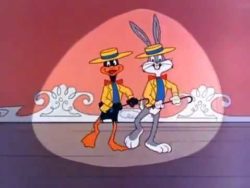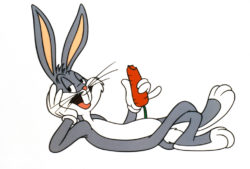It’s Time You Met the Great American Trickster [Part 1]

And on with these excerpts from my previous book, Disruptive Play: The Trickster in Politics and Culture.
Myths…known by the name of The Trickster…. belong to the oldest expressions of mankind. Few other myths have persisted with their fundamental content unchanged. The Trickster myth is found…among the simplest aboriginal tribes and among the complex. We encounter it among the ancient Greeks, the Chinese, the Japanese and inthe Semitic world. Many of the Trickster’s traits were perpetuated in the figure of the mediaeval jester, and have survived right up to the present day…. In what must be regarded as its earliest and most archaic form, as found among the North American Indians, Trickster is at one and the same time creator and destroyer, giver and negator, he who dupes others and who is always duped himself. He wills nothing consciously…. [He] is constrained to behave as he does from impulses over which he has no control. He knows neither good nor evil yet he is responsible for both. He possesses no values, moral or social, is at the mercy of his passions and appetites, yet through his actions all values come into being. But not only he, so our myth tells us, possesses these traits. So, likewise, do…the animals, the various supernatural beings and monsters, and man.
Paul Radin[1]
Virtually all folklores feature a Trickster, and there are at least 69 documented oral traditions.[2] A full list would be endless, and Lewis Hyde states, “If trickster is the boundary-crossing figure, then there will be some sort of representative wherever humans invent boundaries, which is to say, everywhere.”[3] The status of such a character may range from The Fool who unlocks the ability to transform the social order only to renounce it, to the master storyteller and powerful deity. In all cases, the disruptive nature of this character who personifies play calls the rational order of society into question and presents opportunities to transcend it. The more we learn, understand, and accept the Trickster into our collective psyche and our political reality, the more we can embrace such irrationality, the more our society can develop and grow.
In other words, we behold Bugs Bunny! Universal and familiar Bugs Bunny is the most direct route to understanding the Trickster personality. The Trickster, like Bugs, is compulsively at play, and the rapid plot shifts, gender bending, unresolved situations, and moral ambiguities found in Bugs Bunny cartoons and Trickster myths correspond to and define play in its most elemental form, where the ruling principle is the lack of one.
As Radin states in the opening quote and as his seminal study and retelling of the Winnebago Trickster myth reveals, the Trickster can in one episode be the master manipulator with wily schemes and in the very next be tricked by others, and in the next, the victim of his own self-inflicted wounds. One Trickster tale may read like a fable with a morality lesson, while the next one is unmoored and adrift in the amoral sea of irrationality.
Like play, Trickster tales are without inhibition and venture as deeply into the irrational as our storytelling skills can carry us. And so we burrow through the tunnel and into the subterranean but cozy clime of Bugs Bunny.
There is a Zulu tale where Trickster is a weasel who manages to move in with a leopard mother and her cubs, whom he successfully plots to eat. Knowing he will be discovered he creates multiple tunnels for his escape. When the leopard mother pursues him, thinking that there is only one tunnel and she will overtake and kill him, he doubles back, sets spears at the entrances and exits, and kills the leopard mother as well.
In Native American tales, Coyote traps his pursuer in a tunnel by setting fires at both ends, catching and cooking his adversary at the same time.[4]
Does this sound familiar? Most of these Indigenous tales are short enough that they could be retold in the five- to eight-minute timespan that classic cartoons run. It is more than coincidence that children’s cartoons, especially those from the Golden Age of American Animation (1930s to early 1970s), tell similar Trickster tales and typically run for about seven minutes. And the hare is one of the common forms of Trickster in Native American and African folklore.

Enter Bugs. Trickster Bugs lives in a warm and comfortable underground home, but he is also a wanderer, and his stock in trade trick is the tunnel, which makes, blocks and blows up opportunities and pranks. Bugs’ persona expands into our culture through satire and mimicry, especially with the kindred Groucho Marx, whose lines (Of course you realize, this means war!) and props (carrot = cigar), stooped pacing, and eyebrow-raising Bugs regularly appropriates.
The ten most frequently portrayed characters in film—Santa Claus, The Devil, The Grim Reaper, Jesus Christ, God, Adolf Hitler, Abraham Lincoln, Sherlock Holmes, Count Dracula, and Bugs Bunny—include only one cartoon character. A gang of artists and writers and directors created Bugs, who quickly rose from guest role to star and became Warner Brothers’ corporate symbol. One of his developers was animator Ben ‘Bugs’ Hardaway, and notes referring to Bugs’ Bunny eventually morphed into the name that stuck, sans the possessive apostrophe. Early Bugs appeared in 1938 and 1939, with the first definitive version starring in the 1940 Academy Award-nominated A Wild Hare. Some of the 20th century’s greatest talents shot Bugs, like a cannonball, into the heart of the American psyche: Directors Tex Avery, Chuck Jones, Fritz Freleng, Robert McKimson and Bob Clampett; Voice Mel Blanc; and Composer and Conductor Carl Stalling. Ironically, Bugs Hardaway had left the Leon Schlesinger/Warner Brothers studios by this time, and went on to invent Woody Woodpecker for Walter Lantz Studios.
Stay tuned for Part 2. And as we approach the May 31 launch of Tricking Power into Performing Acts of Love, and YOU, good friend, are invited to the party.
[*] https://www.lyricsondemand.com/tvthemes/thisisitbugsbunnyoverturelyrics.html
[1] Radin, Paul, The Trickster: A Study in American Indian Mythology (New York: Schocken, 1956), pp. xxiii-xxiv).
[2] Wikipedia search, April 7, 2022.
[3] Hyde, Lewis, Trickster Makes This World (New York: Farrar, Straus and Giroux, 1998), p. 356.
[4] Hyde, Lewis, Trickster Makes This World (New York: Farrar, Straus and Giroux, 1998), p. 48.

Folks! You haven’t heard from me lately, I’ve been tied up with matters of cosmic significance, but hear me now! Especially y’all from the great big town of Portland, Oregon and beauteous Clark County, Washington., Come together, people, for the entertaining and hope-provoking fun of meeting up with The Trickster in Politics and Culture: I’ll...
I mean, IF you find yourself in Sultan on May 18th . . . (at NOON) You just might find Your Trickster Self . . . Squeeeee!!!! I’ll be making a fun presentation at The Sultan Library 319 Main St Sultan, WA 98294 Saturday May 18th at Noon Tricking Power into Performing Acts of Love...
Haven’t seen the movie “Poor Things?” Want its surprises? Then GO SEE IT before you read this… and in the meantime, click the image below v v v A LITTLE PLUG FOR YOU BOOK CLUBBERS [CLICK!] In their 2018 period comedy The Favourite, Arizonan Emma Stone and Athenian Yorgos Lanthimos gave us clues of mischief...